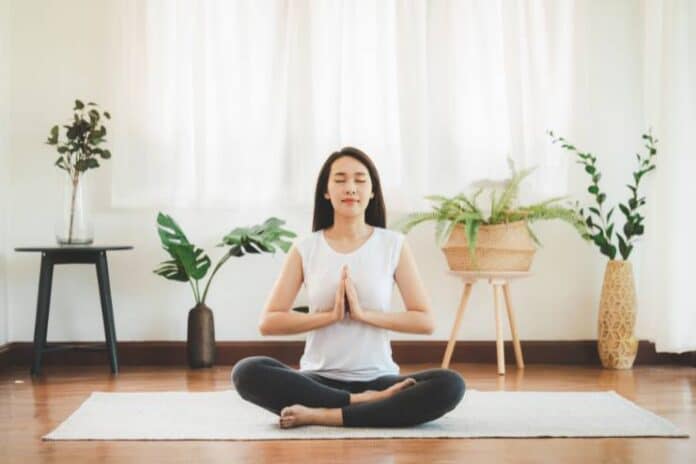Affiliate Disclaimer
Some links in this article are affiliate links. We may earn a small commission if you make a purchase through these links, at no extra cost to you. We only recommend products we find useful to our readersA Sunday recovery yoga will help you relax at the end of the week while rejuvenating your body and mind. This relaxing yoga session works on the body’s flexibility, stress reduction, and muscle recovery. Recovery yoga emphasizes the reduction of body tension and stress and improvement in the self-healing ability. You’ll work your way to relaxation through careful breathing for holistic wellness. Join us for gentle yoga that helps the body and mind.
Warm-Up
Start with a minimal 5-10-minute yoga warm-up. Taking a few minutes to warm up will make your body more adaptable to deeper stretching. Try this simple sequence of stretches:
- Cat-Cow Pose
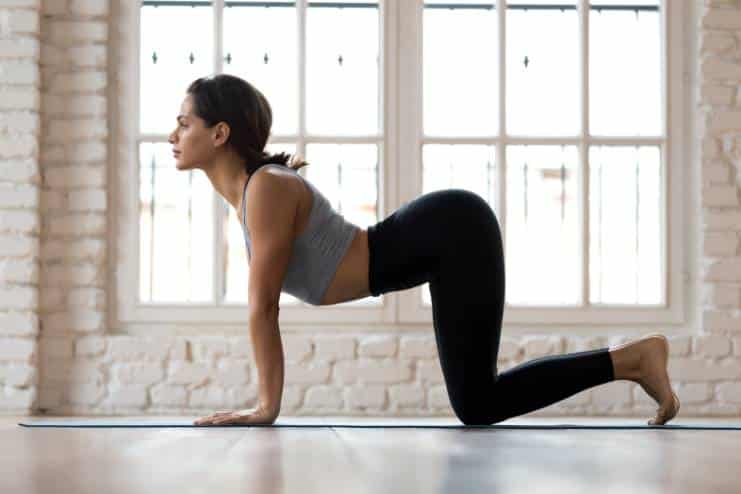
- On all fours with your wrists underneath your shoulders, and knees directly under your hips.
- Arch your back and lift your tailbone on an inhale into Cow Pose. Round your spine and tuck your chin in toward your chest on an exhale into Cat Pose.
- Do this for 1-2 minutes to free your spine and warm up your body.
- Child’s Pose
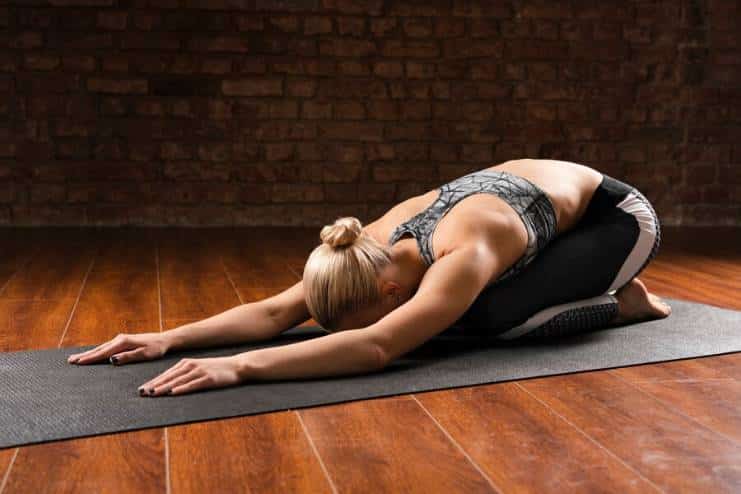
- Sit back onto your heels, widening your knees as much as possible with your arms extended forward.
- Lower your forehead to the mat and breathe deeply.
- 1-2 minutes to gently stretch the back, hips, and shoulders while calming the mind.
- Seated Forward Fold
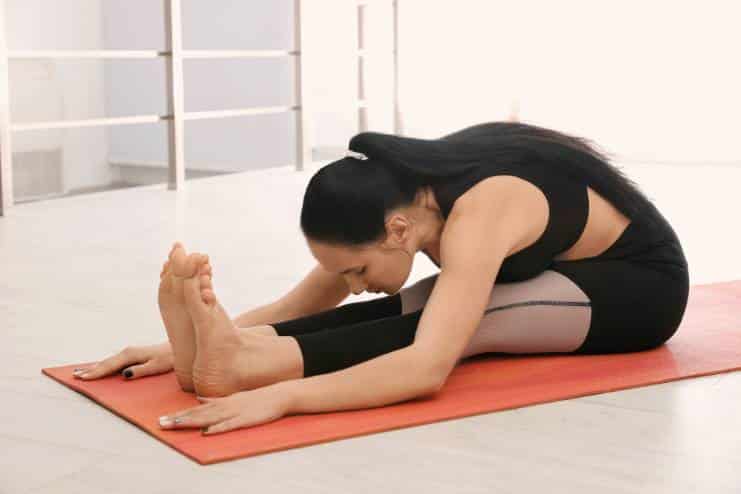
- Sit with your legs extended straight in front of you.
- Hinge at your hips and reach for your toes or shins, keeping your back as straight as possible.
- Hold for 1-2 minutes to stretch the hamstrings and relieve tension in your lower back.
This warm-up will increase blood flow, prepare your muscles, and set a relaxing tone for the rest of your yoga practice.
Pose 1: Downward Dog
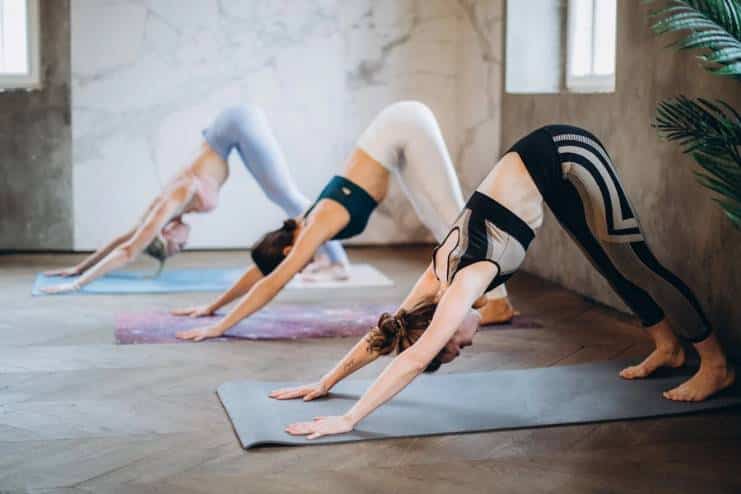
Downward Dog is a foundational, full-body yoga stretch.
How to Perform Downward Dog with Proper Form:
- Begin on your hands and knees, with your wrists aligned under your shoulders and knees under your hips.
- Push back, lifting the hips and straightening the arms. The end position is in an upside-down “v” with your head between your arms and your back straight.
- Make sure your hands are shoulder-width apart and your feet hip-width apart. Press firmly into the mat with your wide, extended fingers and distribute your weight equally between your hands and your feet.
- Pull the chest toward your thighs, and keep the head relaxed between the arms. Try to straighten the legs, but a slight bend in the knees is okay, especially if your hamstrings are tight.
Benefits
- Stretching the Hamstrings and Calves: Downward Dog provides an intense stretch for the hamstrings and calves, reducing tension and increasing flexibility in your legs.
- Opening the Shoulders: Promotes better posture.
Recommendation
Stay in the Downward Dog pose for 5-10 deep breaths. Feel the length of your spine on each inhale and a deepening of the stretch on each exhale.
Pose 2: Pigeon Pose
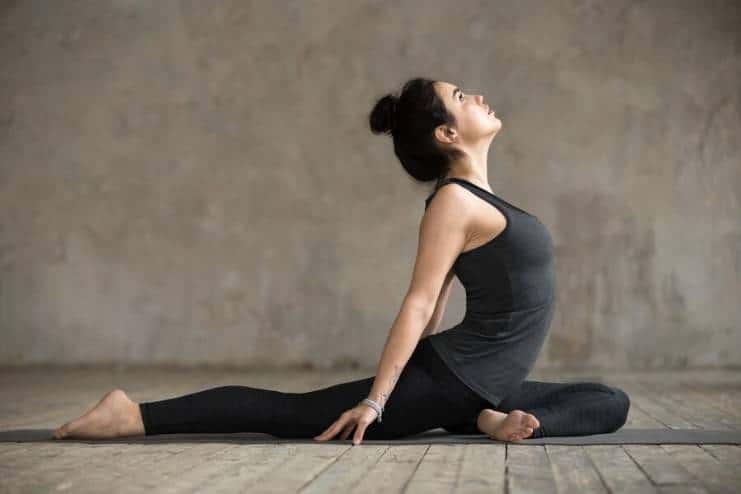
Pigeon Pose is a hip-opening yoga pose that works on deep-seated tension and increases flexibility.
How to Perform Pigeon Pose
- Start in a tabletop position on your hands and knees. Bring your right knee forward so that it’s placed down behind your right wrist. Bring the right shin toward the body so it’s angled slightly, with your right foot under your left hip.
- Extend your left leg straight behind you, the top of the foot on the mat but anchoring through the left foot; hips are squared to the front of the mat.
- Lengthen the spine on inhalation. Open the chest, lifting the heart up toward the ceiling. As you exhale, fold forward, with forearms onto the mat or arms extending out in front of you. Keep your hips rooted down and your breath steady.
Benefits
- Hip Opener: Pigeon Pose is one of the best postures for opening up the hips—targeting the hip flexors, the glutes, and even the piriformis muscles. The stretch is most warranted in cases when a person sits for long periods or when a person engages in activity that makes the hips tighter.
- As Pigeon Pose gives a deep stretch around the hips, it further helps in releasing any kind of stored tension, bringing about improbability and less discomfort in the lower back or hips.
Recommendation
Hold Pigeon Pose for 5-10 deep breaths on each side, using your breath to help sink deeper into the stretch on each exhale. Switch sides and do the same on the left leg. Of course, this not only improves flexibility but also promotes relaxation and stress relief—it’s one of the main recovery yoga poses.
Pose 3: Cobra Pose
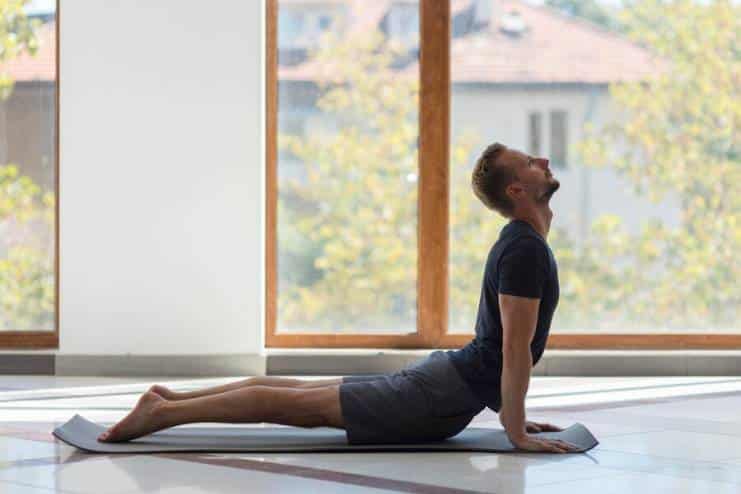
Cobra Pose (Bhujangasana) is a gentle backbend that lengthens the spine, tones the back muscles, and increases flexibility in the spine. Here goes the step-wise description of how to carry out Cobra Pose with consideration to body alignment.
Steps to Perform
- Lie on the abdominals, the legs stretched straight back, and the dorsum of the feet in contact with the floor. Place the hands underneath the shoulders and keep the elbows close to the body.
- Engage your core by drawing your navel slightly towards your spine. Press down through your hands, and on an inhalation, slowly lift your chest off the ground, keeping your elbows slightly bent and close to your body.
- Gaze forward or slightly upward with a little extension in the neck. Relax the shoulders, and draw them down your back away from the ears and toward each other into the space between the shoulder blades. The chest will open as you arch the back.
Benefits
- Back Stretch: Cobra Pose is an excellent pose to give you deep stretches of the back muscles, which tackle tension and stiffness.
- Spinal Flexibility: This pose is aimed at getting flexibility in the spine to eventually attain a better posture and a lower rate of back pain.
- Core Activation: When engaging properly in Cobra Pose, they should feel the activation of their deep core muscles which gives a sense of strength and stability.
Recommendation
Hold Cobra Pose for 5-10 deep breaths, breathing in and out. While you breathe, notice a gentle stretch along the spine, and expansion through the chest, open and relaxed.
Pose 4: Seated Forward Bend
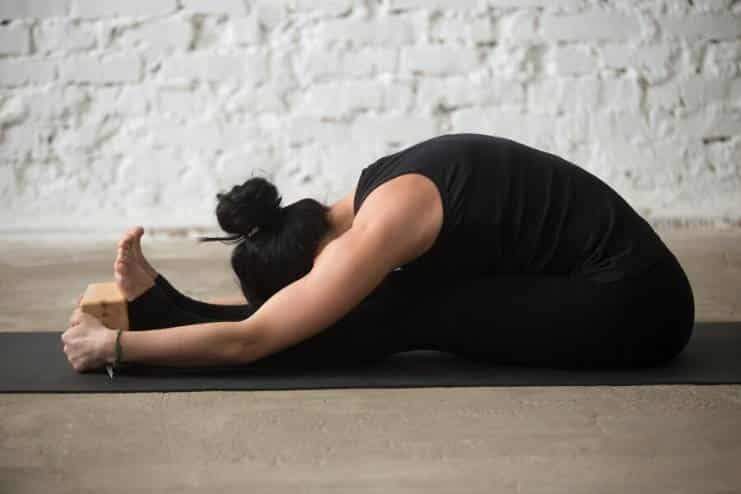
Seated Forward Bend (Paschimottanasana) is a calming asana that stretches the hamstrings, spine, and lower back to achieve deep relaxation.
How to Perform
- Start by sitting on the yoga mat with your legs stretched straight out in front of you. Hold your feet upright with your toes pointing towards the ceiling, and maintain a tall and straight spine.
- Inhale deeply, lengthening your spine upward. As you exhale, lengthen at your hips, extending your hands toward your toes. If the hamstrings feel tight, you might want to slightly bend your knees so that you maintain length in your spine.
- Reach as far as comfortable, whether it’s grasping your shins, ankles, or feet. Focus on keeping your spine elongated rather than rounding your back. Relax your neck and gaze toward your legs or feet.
- Hold the position for 5-10 deep breaths, each exhale allowing your body to relax a little more. You will feel a slight stretch in the hamstrings but mostly the lengthening of the spine.
Benefits
- Hamstring Stretch: This pose is a great hamstring stretcher. It allows the legs and the lower back to become more flexible.
- Spine Lengthening: It lengthens the spine, providing comfort to the tightness in the back and helps one to maintain better posture.
- Relaxation: Seated Forward Bend is good for instant relaxation and meditation. It is an excellent asana to relax the mind and release stress immediately.
Recommendation
To deepen the stretch, draw your torso forward towards your thighs, and it allows your body to rest and release tension as you embrace a state of calmness.
Pose 5: Child’s Pose
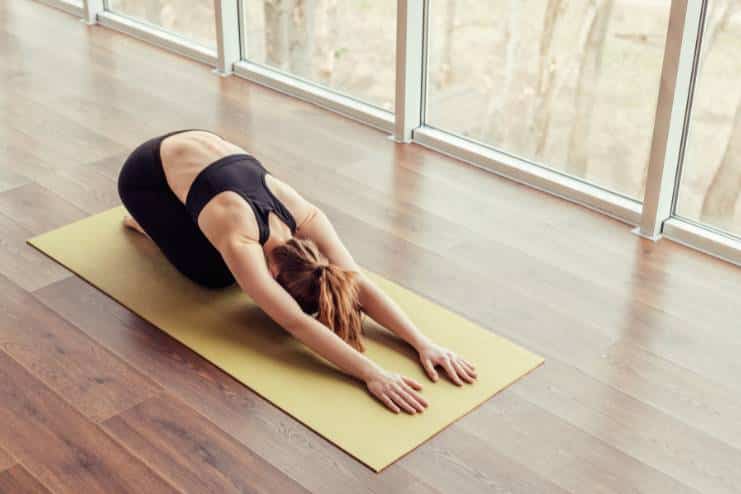
Child’s Pose (Balasana) is a gentle restorative yoga pose intended to infuse deep relaxation of the mind and body. It is often used as a resting pose during yoga sessions when you seek relief from stress or want to calm the nervous system.
Steps to Perform
- Start on your hands and knees in a tabletop position. Align your wrists under your shoulders and knees under your hips.
- Bring your big toes together and gently widen your knees toward the edges of the mat. As you exhale, slowly lower your hips back toward your heels.
- Extend the arms forward with the palms on the mat to lengthen and stretch, lowering your chest down toward your thighs. If this is uncomfortable, the arms can rest beside your body with the palms facing up.
- Now drop your forehead down to the mat, closing your eyes down if you wish, to receive a subtle stretch down your spine, shoulders, and hips.
- Hold this pose for 5-10 slow, deep breaths. Gradually, with each breath, you should feel your body release the stress. Let each breath pull you deeper into this pose, releasing the remaining tension.
Benefits
- Mind and Body Relaxation: Child’s Pose is a powerful relaxation pose, soothing to the mind and helpful in relieving stress and fatigue.
- Spine and Hip Stretch: It gently stretches the hips, thighs, and spine, hence it forms an effective stretch for releasing tension from these areas.
- Grounding: The pose encourages a sense of grounding and connection with the breath, helping to calm the mind and bring a sense of peace.
This pose is an excellent way to conclude a yoga session or to take a break whenever you need to restore energy and focus.
Cool Down
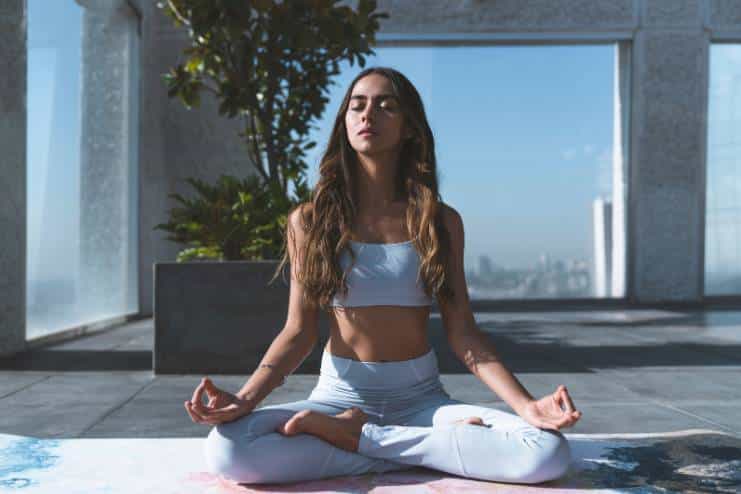
The cool-down stage of your recovery yoga practice allows the mind to cool down and the body to relax. This 5-10-minute practice includes some deep breathing exercises and a little meditation to bring the system from the physical practice to the mental silent mode.
Deep Breathing Exercise: Start with Anuloma-Viloma (Alternate Nostril Breathing) to balance energy, calm, and relax the nervous system. Sit in an easy posture, keeping the spine straight. Close the right nostril with your thumb and slowly breathe in through the left nostril. Hold the breath, close the left nostril, and breathe out through the right nostril. Practice 5-10 rounds.
Meditation: Upon completion of the breathing exercise, take a few moments for meditation. Concentrate your mind on the breath as it rises and falls in your chest. Let the remainder of your tension drain out and let your thoughts simply pass. Allow this short moment of peace to center yourself, working towards relaxation of body and mind.
This is where finishing your practice with deep breathing and meditation helps not just in recovery but in having a sense of peace and well-being.
Conclusion
A relaxing recovery yoga session has positive effects on the body and mind. Flexibility is improved by major muscle stretches from this gentle practice in the recovery yoga session. It promotes relaxation and reduces stress from the exercises of the past few days. By focusing on deep breathing and mindful movements, recovery yoga aids in muscle recovery and supports overall well-being.
If practiced regularly, these poses contribute to increasing your range of motion and preventing injuries. More than that, for an athlete in need of recovery or for anyone in pursuit of relaxation, time invested in a soothing yoga practice will prove very effective for rejuvenating the body and mind.
References
- https://www.verywellfit.com/cat-cow-stretch-chakravakasana-3567178
- https://www.yogajournal.com/poses/child-s-pose/
- https://www.yogajournal.com/poses/seated-forward-bend/
- https://www.yogajournal.com/poses/downward-facing-dog/
- https://www.webmd.com/fitness-exercise/how-to-do-pigeon-yoga-pose
- https://www.yogajournal.com/poses/cobra-pose-2/
- https://www.yogajournal.com/poses/seated-forward-bend/
- https://www.verywellfit.com/childs-pose-balasana-3567066
In this Article















